 |
Welta Gucki
Welta was a succesful camera maker based in Freital near Dresden that almost exclusively made folding cameras for a wide range of film formats. One of their first models was the Gucki, a small folding camera available in both 6x4 and 3x4 format using 127 rollfilm. The 3x4 is the most common model. It had a lens mounted on a pop-out base plate held parallel to the film frame by a pair of struts and a cog mechanism, quite similar to the construction found on the Korelle 3x4 and the Merkel Metharette, although on the latter the struts are horizontal instread of vertical on the Gucki.
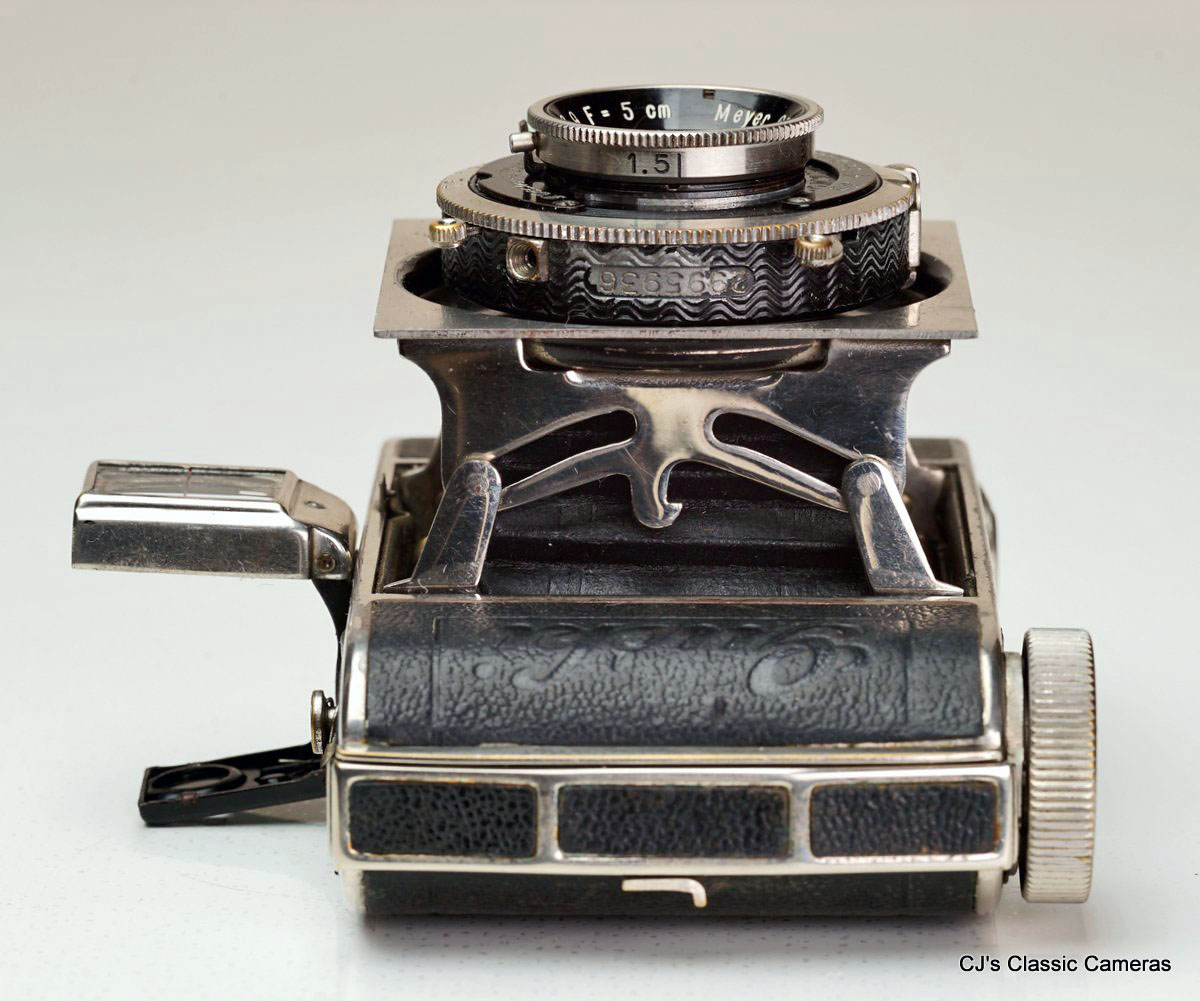
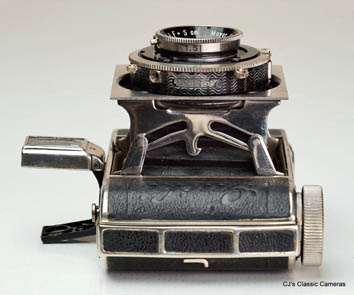
A late production Welta Gucki from around 1934 with Meyer Trioplan 50mm f/2.9 lens in Compur shutter. Late production examples had a different back door clasp and extra chrome edges across the top and the bottom of the frame. This particular example is unusual by having a polished metal base plate, although I am quite sure it used to be painted black originally, as standard on other Guckis. The photo on the right shows the strut mechanism in more detail.
Rodenstock Citonette (Welta Perle)
Welta Perle was the name for a range of pre-WWII folding cameras with different film formats, from 4.5x6 to 9x6 cm. They were quite similar to cameras of other makers from that era such as Balda and Zeiss Ikon, but were characterised by having the wind knob (or key on earlier models) at the bottom of the camera and by having a rather large shutter size typically reserved for larger-format cameras. The Welta Perle had fold-up viewfinders except for the very latest production, which had a Galilean viewfinder with a basic (near vs. far) parallax correction. After WWII the Welta Perle was replaced by the Welta Weltax, which looked very similar but had the viewfinder in the middle of the top plate instead of to the left on the Perle.
The Welta Perle was also sold by Rodenstock under the name Citonette, an example of which can be seen below. Rodenstock was a well-known lens maker, but did sell rebranded cameras with, naturally, their own lenses. They are relatively rare, some of the better known ones are the Ysella (Zeca Goldi), Rodella (Metharette) and Robra (Baldax), but information on these models is sparse. As a sidenote, Rodenstock still exists, focussing on eyewear (which was one of their key products from the start), whilst its photographic lens division was sold off but still sells high-quality large format optics under the name Rodenstock.
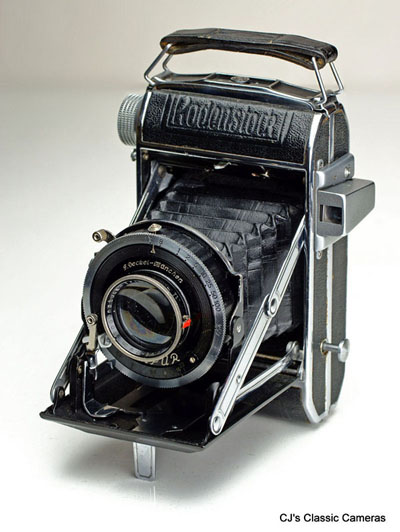
| |
A Welta Perle rebranded as Rodenstock Citonette with Rodenstock-Trinar-Anastigmat 75mm f/2.9 lens in Compur shutter. The shutter serial nr. dates this camera to near the beginning of WWII. This example is a 4.5x6 format camera for 16 exposures on 120 rollfilm.
|
Welta Trio
The Welta Trio was a for its time affordable 6x9 rollfilm camera with relatively simple specifications. It was equipped with a framefinder as well as a small brightfinder. I am not quite sure how the Trio differed from the 6x9 Perle (see above), most likely it was just a slightly cheaper, less well constructed version of the latter. Nevertheless, the Trio came with a similar range of high-quality shutters and lenses.
|
A Welta Trio with Steinheil Cassar 105mm f/3.8 lens in Compur shutter.
|
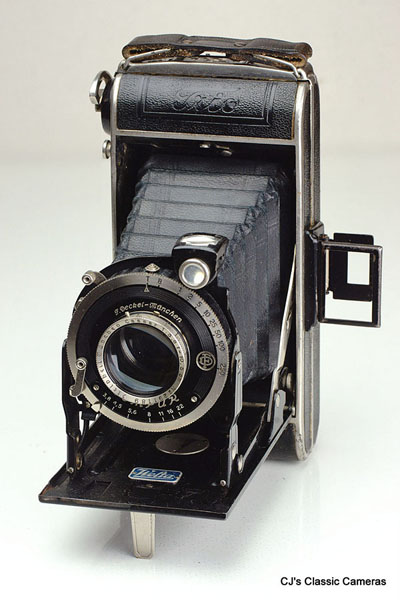
|
Welta (?) 9x12 plate camera
In the early 1900s box and simpler rollfilm cameras were the equivalent of today's point and shoot cameras, whereas large format plate cameras were the equivalent of advanced SLRs. They were highly versatile cameras, with a ground glass at the back of the camera showing the exact composition and focus of the scene, and extendable bellows suitable for landscape as well as portrait and close-up photography. They were slow to handle, as the ground glass needed to be replaced with a glass film plate for each exposure, but the quality of the photos more than made up for it. Naturally, these were expensive cameras only affordable by few people, generally professional photographers.
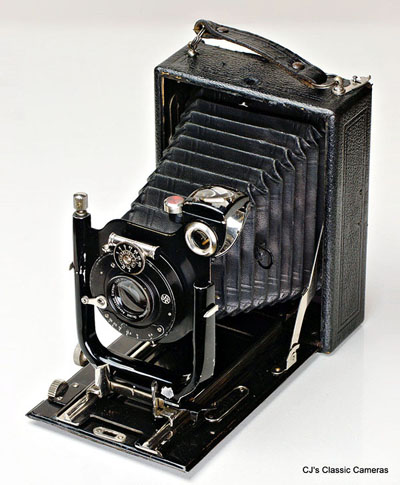
| |
An unmarked (Welta?) 9x12 plate camera with Rodenstock Munchen Doppel Anastigmat Eurynar 135mm f/6.5 lens in IBSO shutter. Based on the serial# of the lens the camera dates from around 1918. The IBSO shutter had a pneumatic shutter speed adjustment (the little piston on top of the shutter), as at the time geared speedcams, like in the later IBSOR, were not yet introduced.
|
The example shown here is typical of the plate cameras of that era. The lens was a Rodenstock Eurynar, which was a common lens at the time that could be found on plate cameras by Ihagee, Certo, Glunz and Welta amongst others. In fact, this example was quite likely made the latter; the struts match those of the Weltas I have seen and also the red spirit level appears typical of Weltas. However, the name Welta did not appear until 1919 while this example is possibly from 1918, when the company was still known as Weeka-Kamera-Werk. As this example unfortunately has a non-original ill-fitting back plate it is hard to be certain.
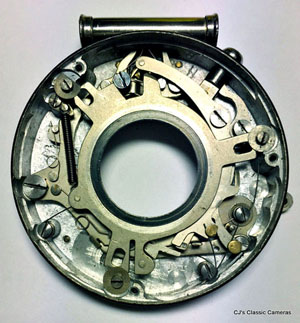
| |
Partially dismantled IBSO shutter with shutter blades removed to show the internal mechanism. The IBSO shutter had a pneumatic shutter speed adjustment (the little tube on top of the shutter, which contains two pistons), as at the time geared speedcams, like in the later IBSOR, had not yet been introduced.
|
In terms of features, the camera had double extension bellows with a rising and falling front with side swing adjustment, i.e., the lens could be moved sideways and up and down relative to the film plane. This way one could adjust compositions without the need to point the camera up or down, thus avoiding distortion of the scene. The double extension below allowed focussing down to about 50cm from the film plane.
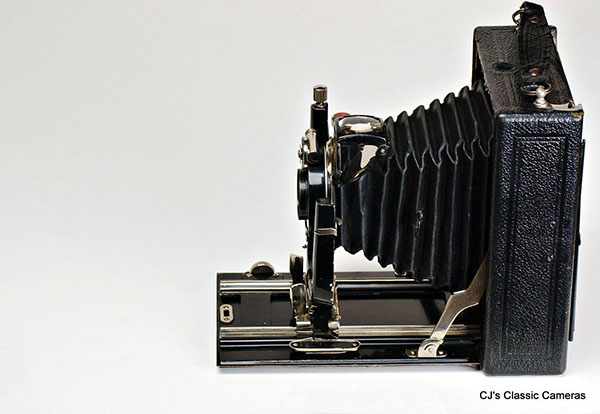
Side view of the Welta plate camera focussed at infinity. Move your mouse over the photo to see the bellows at full extension.
Welta Perfekta
This model could as easily have featured under the TLR cameras, as it is a rather rare breed: a folding TLR, by Welta. Not many of this type of camera were made, the KW Pilot Reflex and Zeca Zecaflex are the main ones I can think of, so the concept clearly did not catch on. In principle the idea seemed to have merit. TLR (twin lens reflex) cameras like the Rolleiflex were quite bulky, so the ability to fold them so they would fit in a (admittedly large) pocket seemed a step forward. However, there were flaws. In the case of the Perfekta, there were considerable light leaks around the ground glass, so the image wasn't as clear as it could be. Also, the camera was complex to build, which made it expensive for the manufacturer as well as the client. So in the end the concept didn't last.
|
That does not mean it was a bad camera, in fact I think it was a marvel full of clever engineering. The folding strut mechanism was sturdy and secure, and the viewfinder hood moved forward when the camera was folded to make it as compact as possible. The mirror would swing into place when the camera was opened. The taking lens sat on a helical focus mechanism operated by a lever on the left-hand side (from the user's perspective) and the viewing lens focus was coupled to the taking lens by a shaft. The camera was also equipped by an automatic frame counter.
Welta produced an even more elaborate model, the Super- fekta. This was a 6x9 version which had a body that could be rotated relative to its front, allowing landscape as well as portrait style photography which would have been difficult to achieve otherwise.
| |
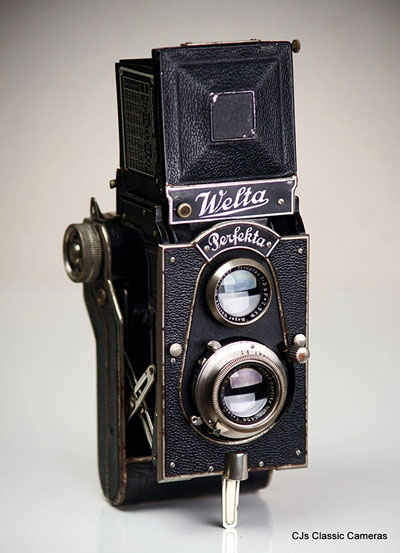
|
(Above) A Welta Perfekta with Meyer Gorlitz Trioplan 75mm f/3.5 lens in Compur shutter. This example was in poor shape when I got it: focus nearly frozen, impact damage, dirty lenses, and so on, but some TLC returned it to working order. When cleaning the mirror I noticed a date written at the back of 11/9.35, presumably the date it was installed in the camera. Similar markings can be found on early Rolleiflex mirrors.
(left) Side view of a Welta Perfekta showing the strut mechanism and the fold-up mirror assembly; (top right) A folded up Perfekta was clearly more compact than regular 'box' TLRs; (bottom right) The inside of the Perfekta was very much like any other 6x6 folding camera, except for the position of the wind spool, which was moved across the film plane to make space for the mirror.
Welta Weltur
The Welta Weltur was the coupled rangefinder version of the Welta Weltax (found further below on this page), but with some significant modifications, most importantly the focus mechanism. Whereas the Weltax had front-cell focussing, the Weltur had a knob-driven unit focussing rail which moved the lens board as well as the rangefinder coupling lever. The focus distance was indicated on a small dial in-between the base of the lens board struts. Like the Weltax the Weltur was available in 6x4 and 6x6 film formats, but a magnificent 6x9 version was also produced. The wind and focus knobs both mounted on the same (bottom) side of the camera. Initially (the Weltur I) it was available in black enamel only, later the top housing was chrome-plated (Weltur II). I haven't seen any Weltur with typical east-German post-WWII shutters, so it appears that unlike the Weltax, production of the Weltur was never resumed after WWII.
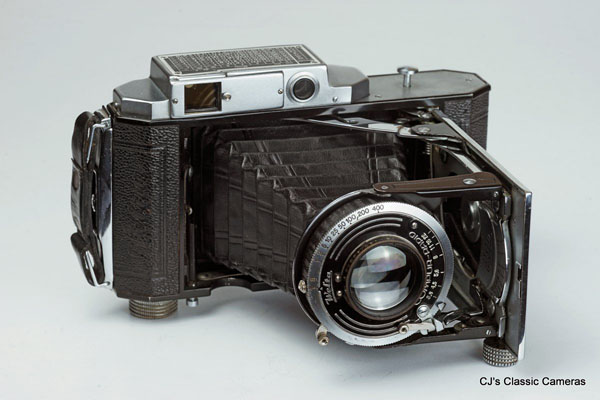
A 1936 Welta Weltur rangefinder in 6x9 format with Schneider Radionar 105mm f/3.8 lens in Compur-Rapid shutter. The focus knob is at the bottom right, at the far end of the front door.
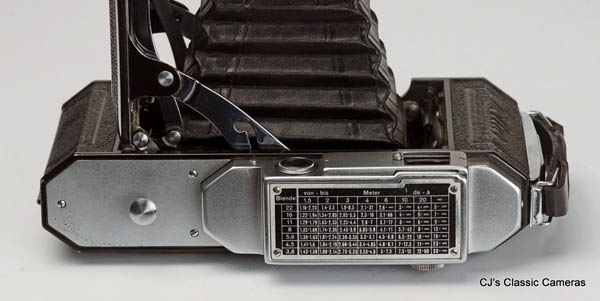
Top view of the Welta Weltur 6x9 format showing the fairly empty top plate, other than a depth of focus scale, and part of the strut mechanism.
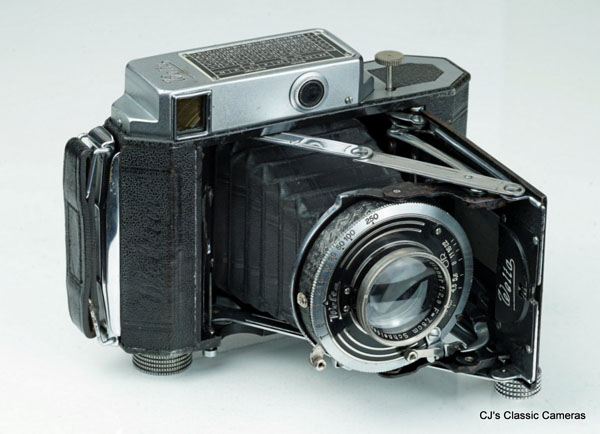
And here is its little sister, a 1936 Welta Weltur II in 6x4 format with Schneider Radionar 75mm f/2.9 lens in Compur shutter. Despite their size difference, the cameras were very similar, the main difference being the strut mechanism.
Welta Welti v1
The Welta Welti was Welta's first 35mm camera and it was clearly inspired by the Kodak Retinas; this was particularly obvious for the earliest version introduced around 1935, i.e., about a year after the Retina. The body shape was nearly identical, and so were the large low-profile wind knobs, the viewfinder, even the styling of the back door clasp. The main difference was the strut mechanism. An additional feature was a switch in the viewfinder for nearby and far subjects. It was also built to similar specification as the Retina, with high-quality lenses and shutters, helical focussing and body-mounted shutter release. To its credit, Welta managed to get a deal with Leitz to use their lenses, and the Welti is one of the few 35mm cameras to have been available with an Elmar lens. A version with Schneider f/2 Xenon was also produced.
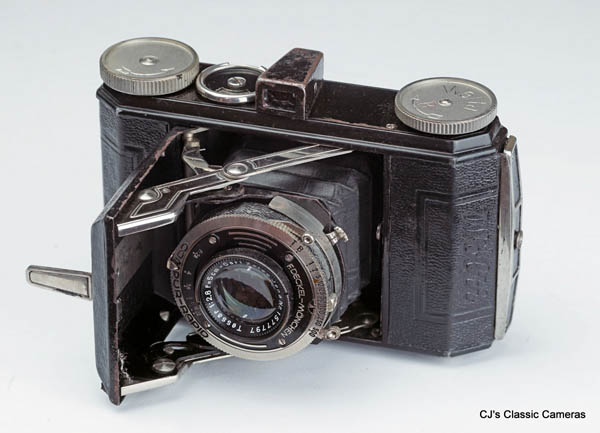
An early production example of the first version of the Welta Welti with Carl Zeiss Tessar 50mm f/2.8 lens in Compur-Rapid shutter. The body had straight edges just like Kodak Retinas. Note the helical focus system, which was also reminiscent of the Kodak Retina.
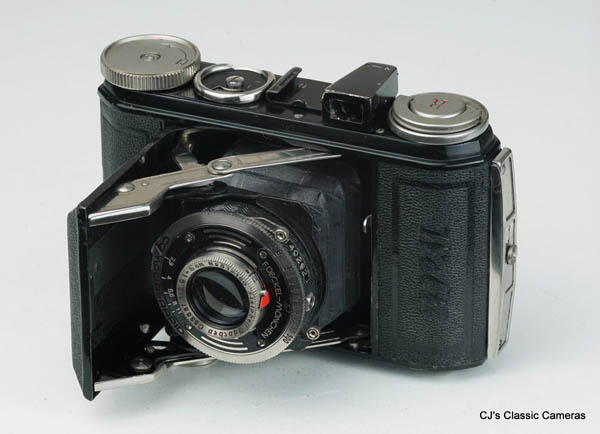
A late production example of the first version of the Welta Welti with Steinheil Cassar 50mm f/2.9 lens in Compur-Rapid shutter. This example is from around 1937, and the body had more rounded edges so it looked less similar to a Kodak Retina than the earlier production models (as shown above). It had an accessory shoe, a hinged crank mounted on the rewind knob and a depth-of-field scale at the back of the camera, all missing on the first production model.
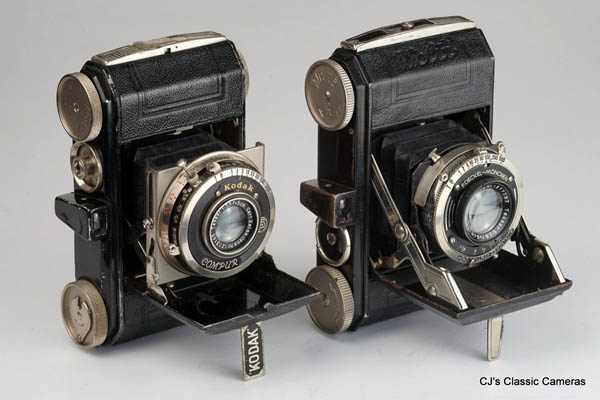
Side by side view of the Welta Welti and Kodak Retina I. It's hard to argue these cameras don't look remarkably similar, and although there isn't much information about this, I suspect Koadk forced Welta to make changes to the camera design as seen in the follow-up models.
Welta Watson (Welti v1)
A lower specification version of the Welti was sold under the name Welta Watson in the USA. Information about the Watson is also scarce, but it had front-cell focussing, and cheaper shutter and lens options than the Welti itself. In that sense, it can be regarded as equivalent to the Welta Weltix, a less-well specified version of the Welti, although I am not sure the Weltix had been introduced yet.
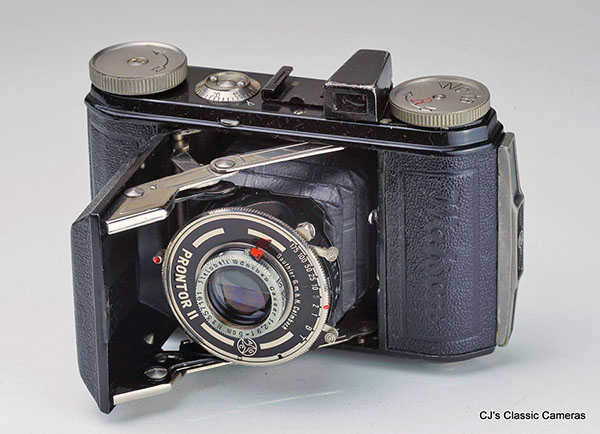
Welta Watson with Steinheil Cassar lens from around 1937.
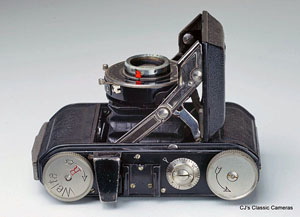
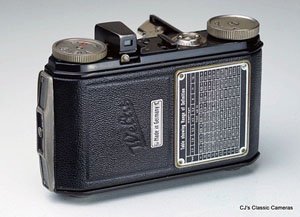
Top and rear views of the Welta Watson, showing the depth of field table mounted on the back. The very earliest Weltas did not have this yet.
Welta Welti v2
I haven't been able to find any factual information, but I imagine Kodak was not happy with this copy of their own new product line, and the fact is that the early Welti is very rare and was updated around 1937 with a different more rounded body shape and longer but narrower control knobs, and off-centre position of the viewfinder. It still had helical focussing and high-grade optics and shutters; a cheaper variant with front-cell focussing and less well-specified lens and shutter combinations was the Weltix. There is also a variant with black enamel instead of chrome top plate (again, like the Kodak Retina...). As Welta was based in East-Germany after WWII, post-war models had CZJ Tessar or Meyer Trioplan lenses and Vebur or Cludor shutters, but the camera was otherwise largely unchanged until introduction in 1950 of the Welti Ic, which had a larger tophousing with integrated viewfinder. The name implies the existence of a Welti Ia and Ib, but these don't appear to have been used in marketing the cameras.
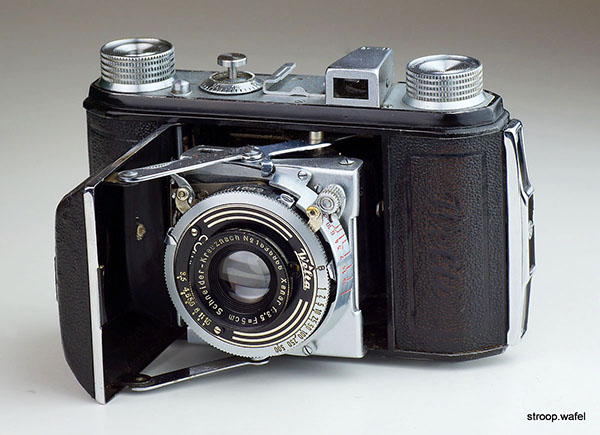
Second variant of the Welta Welti with Schneider Xenar lens in a Compur-Rapid shutter. The lens serial nr. dates this camera to late 1939. Note the funky piston-shaped release button integrated into the frame counter.
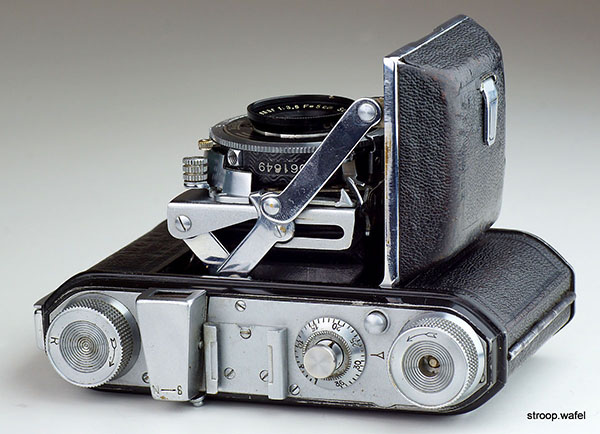
Top view of a Welta Welti.
Welta Weltini II
Like the Welti above, the Welta Weltini was clearly inspired by the Kodak Retinas, in this case the rangefinder models, with features such as high-quality lenses and shutters, helical focussing and body-mounted shutter release. It was solidly made and very heavy. However, the Weltini had a few tricks on its sleeve that even the Retinas could not match. For instance, when closing the front door the lens focus would automatically reset to infinity (whereas on the Retina one needed to do that manually first to be able to close the door) and the shutter button was retracted. A superb little camera.
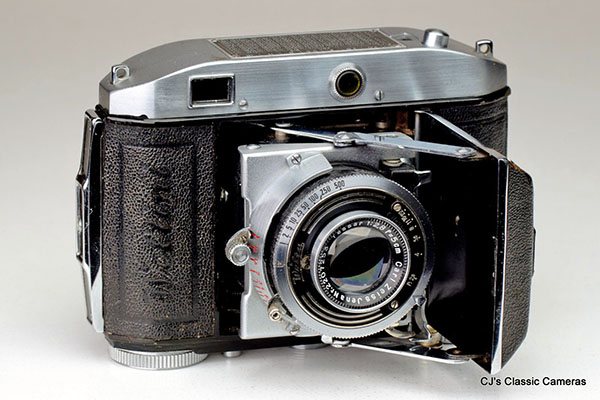
A 1938 Welta Weltini II with Carl Zeiss Jena Tessar 50mm f/2.8 lens in Compur-Rapid shutter. The Weltini I had a more rectaungular top housing that did not cover the whole camera.
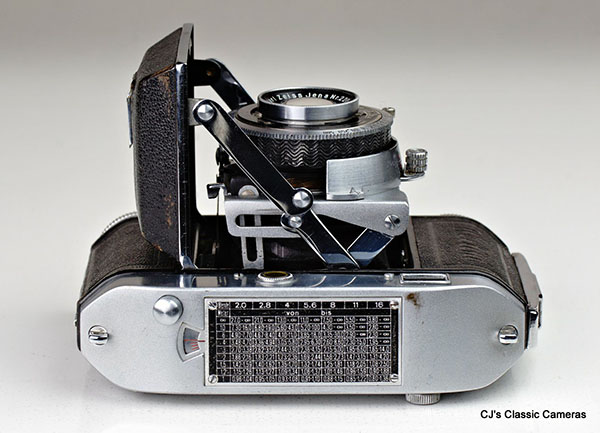
Top view of a Welta Weltini. The depth of field table includes settings for a f/2 aperture, even though this example has an f/2.8 lens, as the Weltini was also available with a fast f/2 Xenon lens.
Rheinmetall Weltax
The Welta Weltax was a folding camera for either 6x6 or 6x4.5 format using 120 rollfilm. The camera came with a mask for 6x4.5 format and a switch on top of the viewfinder. The viewfinder had an additional switch for parallax correction for close up or far away subjects. It was rather similar to the Welta Perle, of which a rebranded version from Rodenstock can be seen above, but it had a wind knob next to the viewfinder instead of at the bottom of the body. Production started before WWII and was continued afterwards; the different models can be recognised by their shutters, which were generally Compur shutter before, and Tempor, Junior or Binor shutters after WWII.
Some or perhaps even most post-war production was built by Rheinmetall VEB in Sömmerda, apparently due to large demand, but perhaps also because Welta started to focus on non-folding cameras such as the ones further down this page. The same Rheinmetall company also build cameras for Ihagee, including some Exa versions. Box and manual were branded Rheinmetall instead of Welta, which suggests a building-under-license kind of arrangement rather than outsourcing production.
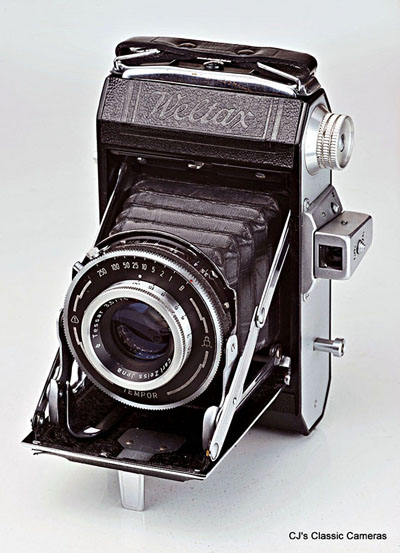
| |
A 1954 Welta Weltax with Carl Zeiss Jena Tessar 75 mm f/3.5 lens in Tempor shutter, typical of post WWII Weltas, as Compur and Prontor shutters were difficult to source in Eastern Germany. This is a Rheinmetall version (engraved at the bottom) as explained above.
|
Welta Belmira
The Welta Belmira was quite a striking camera and I would have called it cute until I saw it in the flesh and realised how big it was. The camera was in fact designed and first produced in 1956 by Belca, the remains in Dresden of Balda-Werke after it moved to West-Germany following the split in Germany. Welta took the production over around 1958.
The Belmira featured a coupled rangefinder but the mirror was incredibly small, and so was the split rangefinder image. The wind lever was quite unique, it was a protruding notch at the back of the camera that one needed to slide straight from left to right. The camera had a Vebur shutter (a Compur-style shutter) and CZJ Tessar f/2.8 lens. The shutter release was situated very prominently next to the lens.
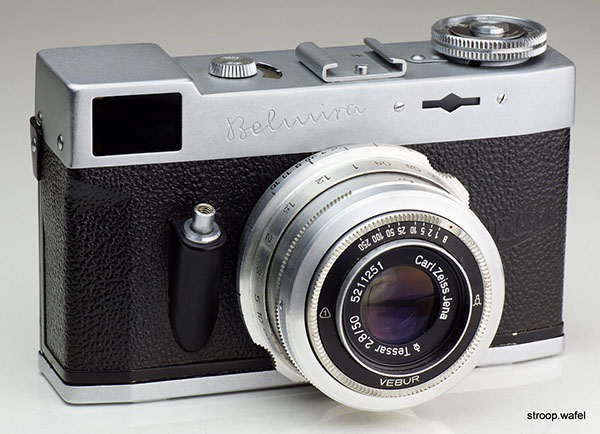
Welta Belmira with Carl Zeiss Tessar 50mm f/2.8 lens in Vebur shutter.
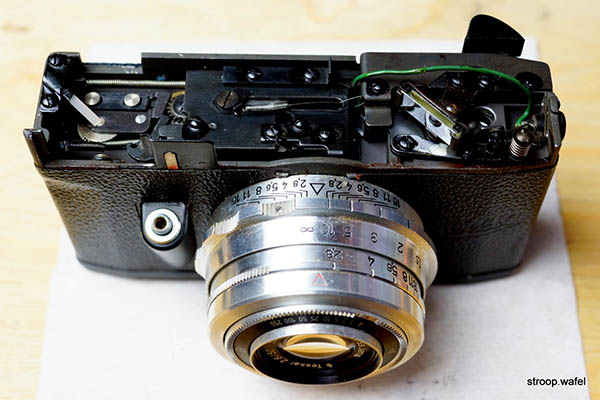
Welta Belmira with its top cover removed. The tiny rangefinder mirror is visible on the far left, the wind lever knob at the top right.
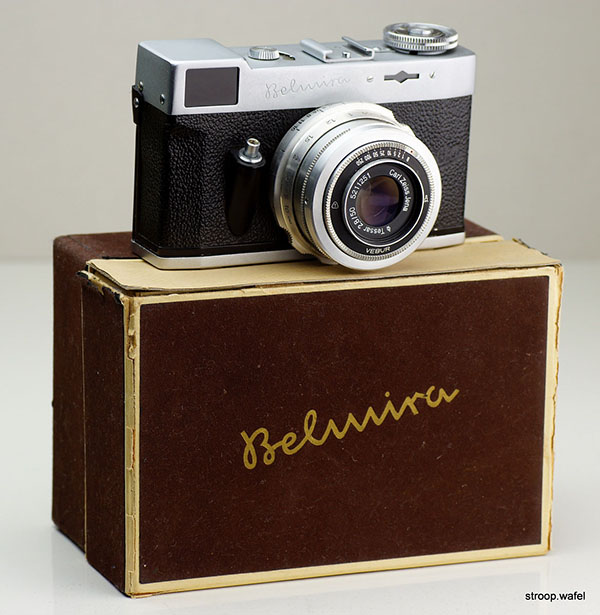
Welta Belmira with its original box covered in purple velvet.
Welta Penti II
The Welta Penti was a range of small gold-coloured half-frame cameras which I can only assume was aimed at the female market segment. Several different coloured trims were available, such as red, blue and green in addition to black and white. The camera used a Rapid cassette cartridge system, or rather the East-German SL cartridge equivalent, which was very similar but missed the automatic ISO setting of the Rapid cassette. It was a half frame camera with a negative size of 16x24mm. The early Penti was a simple viewfinder camera without lightmeter and almost looked more like a clip open purse than a camera. It had a fixed focus lens and manual aperture and shutter speed. The Penti II added a coupled lightmeter, projected in the viewfinder, as well as focussing ability.
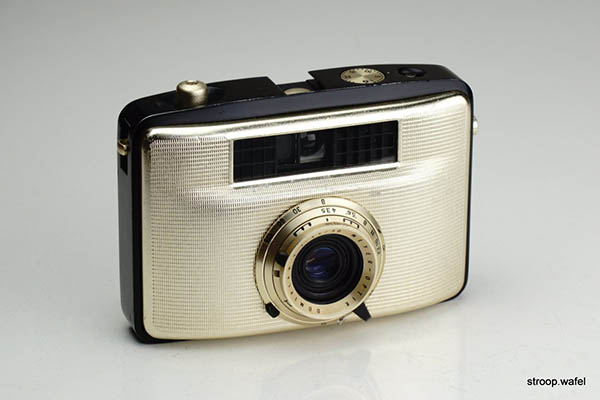
Welta Penti II with Meyer-Optik Domiplan 30mm f/3.5 lens. As opposed to the Welta Belmira above, which appears smaller
in pictures than it really is, the Penti is smaller in reality than it looks on pictures. It easily fits in the palm of your hand.
One of the interesting features of this camera was the film transport: when pushing the release button a plunger would eject from the side of the camera, this needed to be pushed in for the film to be transported and the shutter to be armed. Thus, the camera was always ready to shoot, but there was no option to lock the release button when the camera was stowed away, so I imagine quite a few shots must have been taken accidentally.
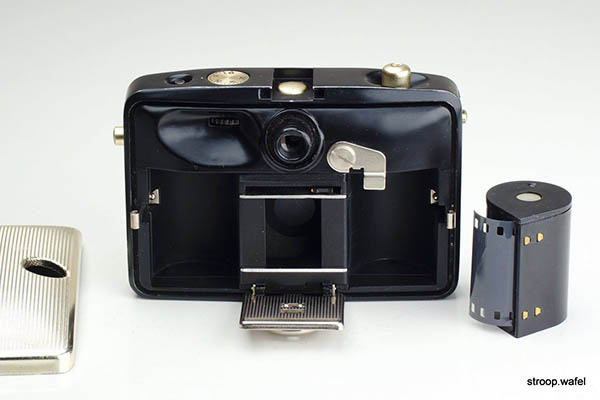
Rear view of the Penti with back removed and film pressure plate down. Also shown is an SL cassette, similar to the Rapid cassette but made from plastic instead of metal and lacking an ISO adjustment. Therefore the Penti had an ISO adjustment setting (lever just about visible on the front view photo above), unlike most other 'Rapid' style cameras.
|

